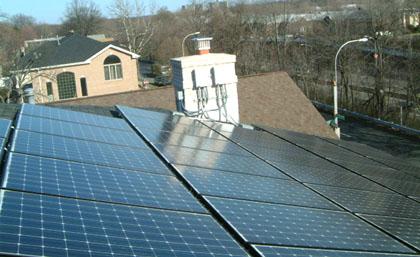By Gene Roman
When Suen Lau decided to install solar panels on the roof of his home, he could not find a local contractor to bid for the job.
He spoke with a number of contractors he found through the New York State Energy Research and Development Authority Web site.
“I called 10 or 15 of them before I connected with someone,” said Lau, 45, of Whitestone. “I discovered that a lot of people don’t want to deal with the red tape associated with doing this kind of work in the city.”
Lau found a contractor and is now enjoying the financial and environmental benefits of living in a solar powered home. But the approval of the design of his panels by Con Edison, along with additional permits, approvals and inspections required by various city and state agencies, totaled almost four months.
“It’s a little bit harder to get this kind of work done in New York City than elsewhere,” said Michael Sapirstein, 36, president of Roofmaster in Woodside, a local installer of green roofs and solar panels.
Charles Virga, Lau’s contractor, of Choose Green Energy, refused to allow any red tape stop him from providing an important service. “To me, if there is a demand, I will supply it.”
NYSERDA spokesman Tom Lynch said that all of the permits and approvals associated with solar power exist to ensure that customers are getting their money’s worth.
Virga installed 50 2−foot−by−4−foot, black−framed, Sanyo 190−watt panels on Lau’s roof.
“These panels produce clean energy and supply 80 percent of my power needs,” Lau said. “I pay less for my energy needs now than I did before the panels were installed.”
Lau estimated that his monthly Con Ed bill averaged $900−$1,000 per month before converting to solar power. He now pays $600−$700 per month.
Solar powered homes also help prevent blackouts because the excess power they produce reverts to Con Ed’s main electrical grid. This extra power can then be used to fortify neighborhoods experiencing a higher demand for electricity.
Solar powered homes require a long−term commitment and large financial investment upfront.
“I am not interested in pushing a system on someone that is not comfortable with it,” Virga said. “Owners of solar powered homes are buying the next 20 to 30 years of electricity now in one shot. That is part of the benefit. They are hedging against future increases.”
Virga’s proposal listed a variety of incentive programs sponsored by the state that assist homeowners to promote clean energy.
They included a 35 percent property tax abatement for residents of cities with populations over 1 million and no sales tax on the purchase of solar equipment.
NYSERDA established many incentive programs because they discovered that solar energy systems installed in the city cost more than those in Long Island, upstate New York and New Jersey. There are 19 solar powered residential homes in Queens, according to NYSERDA.
Both Lau and Virga agreed that the two major obstacles to increasing the number of solar powered homes in Queens are cost and consumer knowledge.
“Most residents don’t even know of the incentive programs that Lau took advantage of,” said Virga.
Lau believes everyone should consider the option of solar power to protect the environment and save money.
“People should look into solar power,” he said. “If they become more educated on the benefits of solar power, then they can make a more informed choice whether or not a system like mine suits them.”


































